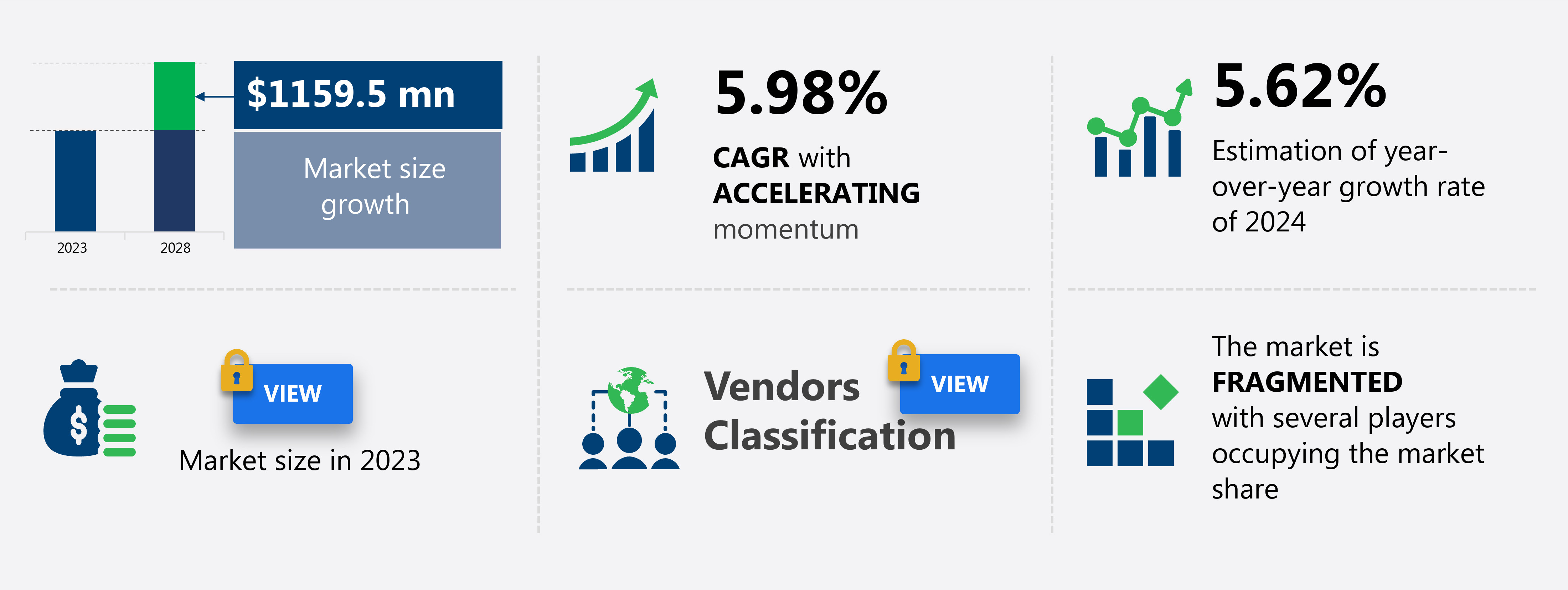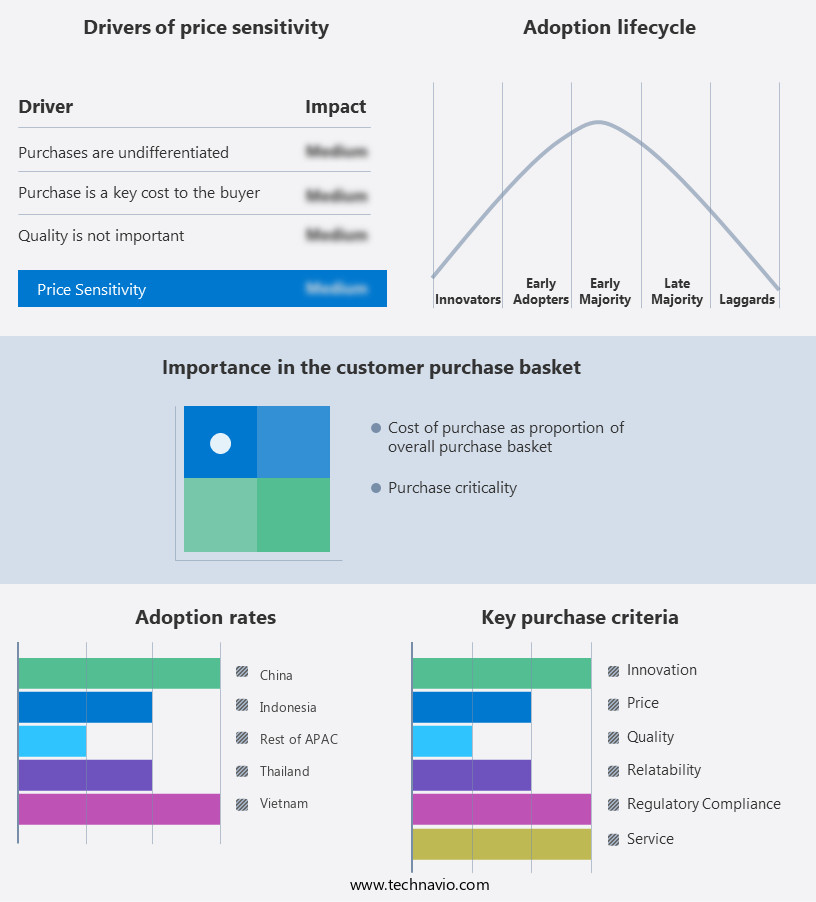APAC Rice Noodles Market Size 2024-2028
The APAC rice noodles market size is forecast to increase by USD 1.16 billion at a CAGR of 5.98% between 2023 and 2028.
- In the dynamic APAC rice noodles market, key drivers include the rising preference for gluten-free food options, catering to the health-conscious population. The versatility of rice noodles, which can be prepared in various ways and paired with an array of flavors, further fuels market growth. However, the market faces challenges as well. The increasing proliferation of alternative noodle varieties, such as wheat and egg noodles, poses a threat to rice noodles' market share. This growth presents significant opportunities for businesses involved in the production, distribution, and retail of rice noodles, including manufacturers, wholesalers, and grocery chains. Companies must innovate and differentiate their offerings to maintain competitiveness.
- Additionally, ensuring consistent quality and authenticity in rice noodle production remains a significant challenge due to the intricacies involved in the manufacturing process. To capitalize on opportunities and navigate these challenges, market participants must focus on product innovation, catering to consumer preferences, and ensuring stringent quality control measures.
What will be the size of the APAC Rice Noodles Market during the forecast period?

Explore in-depth regional segment analysis with market size data - historical 2018-2022 and forecasts 2024-2028 - in the full report.
Request Free Sample
- In the APAC rice noodles market, flavor compounds and product formulation play significant roles in catering to diverse consumer preferences. Energy-efficient processes and optimized process parameters are essential for competitive advantage, reducing production costs and enhancing sustainability initiatives. Sales promotion strategies, such as pricing and omni-channel offerings, expand market reach. Packaging materials and traceability systems ensure product freshness and consumer trust. Innovation strategies, including starch modification and aroma profiling, contribute to improved texture and sensory attributes. Market research and branding strategies are crucial for staying competitive, with a focus on consumer insights and logistics management.
- Sustainability initiatives, like waste reduction and raw material sourcing, are increasingly important for both environmental and cost-effective solutions. Quality assurance and supply chain resilience are key considerations for maintaining production capacity and meeting demand. Noodle firmness and cooking time are essential rheological properties, ensuring consumer satisfaction. Digital marketing and texture profile analysis are integral to reaching consumers and understanding their preferences. Ingredient functionality and preservation methods are essential for maintaining product quality and extending shelf life. Pricing strategies and branding are critical components of a successful business model, requiring constant adaptation to market trends.
How is this market segmented?
The market research report provides comprehensive data (region-wise segment analysis), with forecasts and estimates in "USD million" for the period 2024-2028, as well as historical data from 2018-2022 for the following segments.
- Distribution Channel
- Product
- Form
- Vermicelli
- Flat Noodles
- Stick Noodles
- Roll Noodles
- Application
- Soups
- Stir-fries
- Salads
- Spring Rolls
- Ready-to-Eat Meals
- Ingredient Type
- White Rice Noodles
- Brown Rice Noodles
- Other Grain-Based Rice Noodles
- Geography
- APAC
- China
- Indonesia
- Thailand
- Vietnam
By Distribution Channel Insights
The retail segment is estimated to witness significant growth during the forecast period.
Rice noodles have gained significant popularity in the APAC market due to their versatility and consumer preference. Packaging technology plays a crucial role in maintaining the product's freshness and shelf life, while flavor enhancement techniques cater to evolving consumer tastes. Rice flour quality is a critical factor in ensuring the desired texture and consistency of rice noodles. New product development and production efficiency are key trends, with innovation focusing on protein content analysis, energy consumption, and moisture content control. E-commerce platforms are transforming distribution channels, allowing consumers to purchase rice noodles online. Food safety standards and cost reduction strategies are essential considerations for manufacturers.
Drying process optimization and process automation are important for improving production efficiency and reducing labor costs. Consumer behavior influences rice noodle production, with a growing preference for gluten-free options and sensory evaluation playing a significant role in product development. Waste management and supply chain management are essential for maintaining sustainability and efficiency in the industry. Rice noodle production involves various stages, including starch gelatinization, extrusion cooking process, and quality control systems. Ingredient sourcing and brand building are crucial aspects of retail strategy. Overall, the rice noodle market in APAC is dynamic and evolving, with a focus on product innovation, process optimization, and consumer preferences.

Request Free Sample
The Retail segment was valued at USD 1709.60 million in 2018 and showed a gradual increase during the forecast period.
Market Dynamics
The rice noodles market in APAC is experiencing dynamic growth, driven by evolving APAC rice noodles trends and increasing consumer preference for healthier and convenient options. The demand for gluten-free rice noodles Asia is significant, alongside the continued popularity of instant rice noodles APAC and dried rice noodles market. However, the fresh rice noodles Asia segment is also gaining traction, particularly for authentic culinary experiences. Key product types like rice vermicelli market and flat rice noodles demand remain strong. Advances in rice noodle production technology are crucial for meeting this demand. The rise of organic rice noodles APAC and plant-based rice noodles reflects health-conscious choices and diverse rice noodles applications Asian cuisine. This robust rice noodles market share Asia is evident across countries like the Vietnam rice noodles market and China rice noodles market, demonstrating healthy rice noodles industry growth.
Our researchers analyzed the data with 2023 as the base year, along with the key drivers, trends, and challenges. A holistic analysis of drivers will help companies refine their marketing strategies to gain a competitive advantage.
What are the APAC Rice Noodles Market market drivers leading to the rise in adoption of the Industry?
- The surge in demand for gluten-free products is the primary market driver in the Asia Pacific region.
- In Asia Pacific (APAC), the rise in health consciousness and awareness about celiac diseases is driving the demand for gluten-free food options. Rice noodles, being naturally gluten-free, are increasingly popular among consumers. The packaging technology used for rice noodles is a significant factor influencing consumer preference. Advanced packaging methods ensure product freshness and longer shelf life, enhancing the overall consumer experience. Flavor enhancement techniques and rice flour quality play a crucial role in new product development. Manufacturers are focusing on improving noodle texture through advanced production processes, ensuring production efficiency and cost control. Ingredient costs are a critical consideration in the rice noodles market, with manufacturers constantly seeking cost-effective solutions while maintaining product quality.
- Consumer preferences for diverse rice noodle offerings continue to shape the market landscape. Noodle texture analysis is a key aspect of new product development, with manufacturers striving to cater to varying consumer preferences. The market is expected to witness continued growth due to these factors.
What are the APAC Rice Noodles Market market trends shaping the Industry?
- The trend in the market is leaning towards the diverse range of flavors offered in rice noodles. Rice noodles are gaining popularity due to their availability in various delicious and authentic flavors.
- Rice noodles, a popular food staple in Asia Pacific, are witnessing significant growth due to increasing consumer preference for convenient and flavorful meal options. To cater to this demand, manufacturers are focusing on various strategies such as improving food safety standards, implementing cost reduction strategies, and extending shelf life through optimization of the drying process. These efforts aim to maintain product quality and affordability, while also ensuring consumer satisfaction. Moreover, product innovation is a key driver in the rice noodles market. Companies are investing in research and development to introduce new flavors and protein content analyses to cater to diverse consumer tastes.
- The use of e-commerce platforms is also increasing, enabling wider reach and accessibility for consumers. Energy consumption is a critical consideration in the manufacturing process, and manufacturers are focusing on process optimization to minimize energy usage. This not only reduces costs but also contributes to sustainable business practices. Overall, the market is dynamic, with players continually striving to meet consumer demands and stay competitive.
How does APAC Rice Noodles Market market faces challenges face during its growth?
- The proliferation of increasing noodle variety launches in the Asia-Pacific region poses a significant challenge to the industry's growth trajectory.
- The market is experiencing significant competition due to the increasing number of noodle variety launches. For instance, in December 2023, Nissin introduced new Fusion Noodle flavors, such as manchurian and schezwan. In April 2022, Yu launched instant noodles (Yudles) with chilli manchurian and zingy cheese noodle bowls. Similarly, in February 2021, Marico entered the market with instant noodles under the Saffola brand in India. These continuous product introductions are posing challenges to rice noodle production and growth in the region. To maintain competitiveness, rice noodle manufacturers are focusing on implementing quality control systems and moisture content control during production.
- Process automation is also a key trend in the industry, as it enhances efficiency and reduces human error. Waste management is another critical area of concern, with manufacturers exploring sustainable solutions to minimize environmental impact. Consumer behavior is another crucial factor influencing market dynamics. As consumers become more health-conscious, there is a growing demand for rice noodles due to their lower calorie content compared to other noodle varieties. However, manufacturers must ensure that their products meet consumers' expectations in terms of taste and texture. In conclusion, the market is undergoing significant changes, driven by increasing competition, consumer preferences, and technological advancements.
- Manufacturers must focus on implementing effective quality control systems, optimizing production processes, and adopting automation technology to remain competitive in the market.
Exclusive APAC Rice Noodles Market Customer Landscape
The market forecasting report includes the adoption lifecycle of the market, covering from the innovator's stage to the laggard's stage. It focuses on adoption rates in different regions based on penetration. Furthermore, the report also includes key purchase criteria and drivers of price sensitivity to help companies evaluate and develop their market growth analysis strategies.

Customer Landscape
Key Companies & Market Insights
Companies are implementing various strategies, such as strategic alliances, market forecast partnerships, mergers and acquisitions, geographical expansion, and product/service launches, to enhance their presence in the market.
The market research and growth report includes detailed analyses of the competitive landscape of the market and information about key companies, including:
- Acecook Vietnam Joint Stock Co.
- Bich Chi Food Co.
- FodShop Pty Ltd.
- Foodle Noodle Co. Ltd.
- Greenature Grains and noodle Co. Ltd.
- Kenmin Foods Co. Ltd.
- Kikkoman Corp.
- King Soba
- Leong Guan Food Manufacturer Pte Ltd.
- Lieng Tong Rice Vermicilli Co. Ltd.
- Molina and Sons Phils. Inc.
- Nongshim Co. Ltd.
- Q Phil International Trading
- SA GIANG
- Sapporo Products Inc.
- Suzhou Joywell Taste Co. Ltd.
- Thai President Foods Public Co. Ltd.
- Thaitan Foods International Co. Ltd.
- Vietnam Food Technology Joint Stock Co.
- Woodland Foods Ltd.
Qualitative and quantitative analysis of companies has been conducted to help clients understand the wider business environment as well as the strengths and weaknesses of key market players. Data is qualitatively analyzed to categorize companies as pure play, category-focused, industry-focused, and diversified; it is quantitatively analyzed to categorize companies as dominant, leading, strong, tentative, and weak.
Recent Development and News in Rice Noodles Market In APAC
- In January 2024, Indofood CBP Sukses Makmur Tbk, a leading Indonesian food manufacturer, announced the launch of its new instant rice noodle product line, "Indomie Instant Rice Noodles with Vegetables," catering to the growing health-conscious consumer segment in the APAC region (Indofood CBP Sukses Makmur Tbk Press Release).
- In March 2024, Thai agribusiness giant Charoen Pokphand Foods International (CP Foods) entered into a strategic partnership with Singapore's food technology firm, Tetra Pak, to develop sustainable and eco-friendly packaging solutions for its rice noodle products, aiming to reduce plastic waste in the APAC market (CP Foods Press Release).
- In April 2025, Quaker Oats Company, a subsidiary of PepsiCo, completed the acquisition of a 60% stake in Indian rice noodles manufacturer, ITC's Wai Wai Foods, expanding its presence in the Indian and APAC rice noodles market (PepsiCo Securities Filing).
- In May 2025, the Chinese government announced a new policy to support the modernization of rice noodle production and processing facilities, providing subsidies and tax incentives to encourage investments in advanced technologies and improved production methods, aiming to increase the competitiveness of the Chinese rice noodles industry in the global market (Chinese Ministry of Agriculture and Rural Affairs Press Release).
Research Analyst Overview
The market continues to evolve, driven by consumer preferences, product diversification, and technological advancements. Food safety standards are a top priority, with ongoing efforts to reduce costs through process optimization and shelf life extension. Drying process optimization and ingredient sourcing are critical factors in maintaining product quality and reducing energy consumption. New product development and innovation are key strategies for companies to stay competitive, with a focus on protein content analysis, texture analysis, and flavor enhancement techniques. E-commerce platforms are transforming distribution channels, enabling greater reach and convenience for consumers. Automation technology and process automation are also gaining traction to improve production efficiency and reduce labor costs.
Consumer behavior and brand building are essential elements in the rice noodle market, with retail strategy and sensory evaluation playing crucial roles in market success. Waste management and supply chain management are also important considerations for companies seeking to minimize costs and maximize efficiency. The ongoing unfolding of market activities highlights the importance of continuous improvement in rice noodle production, from raw material sourcing to final product delivery.
Dive into Technavio's robust research methodology, blending expert interviews, extensive data synthesis, and validated models for unparalleled Rice Noodles Market in APAC insights. See full methodology.
|
Market Scope
|
|
Report Coverage
|
Details
|
|
Page number
|
147
|
|
Base year
|
2023
|
|
Historic period
|
2018-2022 |
|
Forecast period
|
2024-2028
|
|
Growth momentum & CAGR
|
Accelerate at a CAGR of 5.98%
|
|
Market growth 2024-2028
|
USD 1159.5 million
|
|
Market structure
|
Fragmented
|
|
YoY growth 2023-2024(%)
|
5.62
|
|
Competitive landscape
|
Leading Companies, Market Positioning of Companies, Competitive Strategies, and Industry Risks
|
Request Free Sample
What are the Key Data Covered in this Market Research Report?
- CAGR of the market during the forecast period
- Detailed information on factors that will drive the market growth and forecasting between 2024 and 2028
- Precise estimation of the size of the market and its contribution of the market in focus to the parent market
- Accurate predictions about upcoming market growth and trends and changes in consumer behaviour
- Growth of the market across APAC
- Thorough analysis of the market's competitive landscape and detailed information about companies
- Comprehensive analysis of factors that will challenge the growth of market companies
We can help! Our analysts can customize this market research report to meet your requirements Get in touch
Research Framework
Technavio presents a detailed picture of the market by way of study, synthesis, and summation of data from multiple sources. The analysts have presented the various facets of the market with a particular focus on identifying the key industry influencers. The data thus presented is comprehensive, reliable, and the result of extensive research, both primary and secondary.
 INFORMATION SOURCES
INFORMATION SOURCES
Primary sources
- Manufacturers and suppliers
- Channel partners
- Industry experts
- Strategic decision makers
Secondary sources
- Industry journals and periodicals
- Government data
- Financial reports of key industry players
- Historical data
- Press releases

 DATA ANALYSIS
DATA ANALYSIS
Data Synthesis
- Collation of data
- Estimation of key figures
- Analysis of derived insights
Data Validation
- Triangulation with data models
- Reference against proprietary databases
- Corroboration with industry experts

 REPORT WRITING
REPORT WRITING
Qualitative
- Market drivers
- Market challenges
- Market trends
- Five forces analysis
Quantitative
- Market size and forecast
- Market segmentation
- Geographical insights
- Competitive landscape







![]() Get the report (PDF) sent to your email within minutes.
Get the report (PDF) sent to your email within minutes.
Complimentary full Excel data with your report purchase.